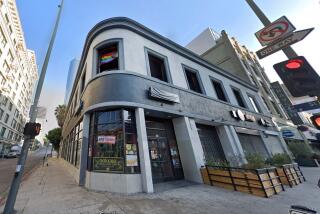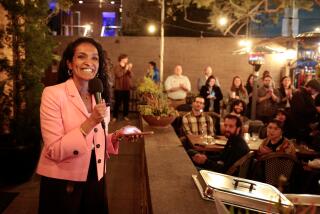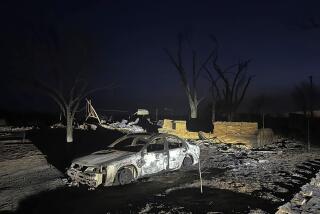Tuscaloosa councilman the go-to guy
The volunteer weaved through the bustling tornado relief camp with its mountains of water bottles and donated clothes, trying to reach the tall, rubicund, red-haired man, the one incongruously dapper amid the twisted metal, the one in the loafers and tie and collared dress shirt — the one who had become the city councilman representing disasterville.
“Hey, Kip, I need your help.”
The problem was portable toilets, overflowing.
The red-faced man found a number on the side of a john and punched it in his cell. “This is Councilman Kip Tyner,” he said. “Listen, I need your help…”
A woman approached in a T-shirt soiled by the struggle: “Hey, Kip.”
Then came an elderly man, his face creased with worry: “Hey, Kip.”
For Kip Tyner, revitalizing Tuscaloosa’s downtrodden Alberta neighborhood has been the great mission of his adult life.
He was born and raised in this modest area just east of the University of Alabama. It’s the place where his family taught him how to love amid the racial turbulence of the 20th century South. It’s the neighborhood Tyner has represented on the City Council for 14 years, a place that had been on the upswing.
Then the tornadoes hit April 27, leveling block after block of houses, ripping scores of once handsome trees from the earth. Now, Tyner has a new mission, rebuilding Alberta, and residents are increasingly turning to the man who fought for the neighborhood when some others just ignored it. “Hey, Kip.”
The woman in the soiled T-shirt was close to tears. He gripped her by the shoulder and pulled her close.
“We just so messed up,” she said. “We ain’t got no lights on Second Street East. And they breaking in in our neighborhood.”
The elderly man asked if he could he borrow Tyner’s cellphone to call his boss. Tyner handed it over.
A heavyset young woman approached, one arm grasping a plastic grocery bag, the other hanging in a sling.
“Did you hurt your arm in the storm?” he asked.
“Yes sir,” she replied. “But how you doing, Mr. Tyner?”
It has been better. The tornadoes that killed at least 340 people across the Southeast claimed 41 lives in Tuscaloosa. Nine of them he counted as friends. His own house was beaten to hell.
“It’s like a member of the family died; Alberta’s so ingrained in me,” he said on a recent Monday morning. For five days he had been out here, listening and helping and hugging — even in better times, Tyner is a big hugger. By now, he had developed a hacking cough and his face was burned the color of a jar of pickled eggs.
“But the more you hear the stories, the more you can’t stay away,” he said. “I think it’s important that people see me out here.”
When Tyner was a child, Alberta was a prestigious address. It was also segregated. Tyner, 55, remembers when African Americans lived in an area known as the “colored quarters.”
“Some people,” he said, “called it worse than that.”
He was in fifth grade when the first two black students arrived at his school. One of them, Alma Dykes, still works on his election campaigns.
Growing up white in Tuscaloosa — where segregationist Gov. George Wallace made his infamous “stand in the schoolhouse door” to prevent integration at the university — Tyner heard a different gospel from his grandfather.
“You treat the colored man just like you would your own family,” he would tell the boy.
In 1966, Tyner’s mother worked on the gubernatorial campaign of then-Atty. Gen. Richmond Flowers, a moderate on race relations who was running against Wallace’s wife, Lurleen. Flowers lost, and Tyner remembers coming home one night to their little brick house in Alberta, astonished by the little cross burning in the yard.
As more blacks moved into Alberta, more whites moved out, though some, like his parents and grandparents, stuck around.
Tyner went to high school and college in Tuscaloosa, leaving only briefly to work for the late John Sparkman, a Democratic senator, in Washington. He returned home to become a TV weatherman — Good ol’ Kip, with his double-breasted suits and Clark Gable moustache and his weekly forecast at 10.
The station was bought out, the owners moved it to the Birmingham suburbs, but Tyner stayed in Tuscaloosa. He started up a daily talk show on cable, which provides most of his income. He decided to run for office.
The heart of his 5th District was majority-black Alberta, by then plagued with crack dealers and prostitutes and neglected Section 8 rental homes.
But Tyner knew it was also full of black people who wanted something better and who knew his face and his heart.
“Kip’s not white, he’s black,” Steve W. Brown, a Tuscaloosa stand-up comedian, has been known to say. “He’s just high, high, high yellow.”
Tyner took office in 1997, and began lobbying for a major beautification program for University Boulevard, the main drag.
He cobbled together a few million dollars, and the city fixed the sidewalks, planted zoysia grass, installed decorative street lamps. When the streetscaping was done, he got on the phone and fought to bring in businesses — the kind of businesses a fancy neighborhood might try to keep out.
“I can’t tell you how many fast food places I’ve called on my own,” he said.
He did more than fast food joints. Alberta attracted an upscale patio furniture place, an auto body shop and a big Piggly Wiggly supermarket.
He cracked down on the Section 8 landlords. He turned a puny police substation into a substantial outpost where, he boasts, 18 officers were stationed for every shift. He helped secure a multimillion-dollar upgrade for Alberta Elementary School.
In the minutes before the tornado struck, he had driven his mother home from the building on University Boulevard where she runs an exterminating business, and where he keeps his district office. They heard the freight-train howl and ran to the basement.
Moments later, he was back on University. All of his work had been ravaged. The decorative street lamps were bent and broken. The patio furniture store was destroyed, as was the elementary school. But the Piggy Wiggly survived, its sign short of a P and a G.
His constituents emerged, dazed and bloody. He tried to console a man who had just lost his wife and two grandchildren.
On this day that started at the tornado relief camp, Tyner left the disaster zone in his Nissan Altima, its passenger-side window broken out by the tornado, its back windshield honeycombed.
He pulled up at a struggling shopping mall in a relatively unscathed part of town, and walked down the clean, near-empty halls toward the set with the wicker furniture where he broadcasts his live hourlong show, “Good Day Tuscaloosa.”
Tyner opened with a rambling 25-minute monologue on the dead and missing, the state of his health and his house, the danger of scam contractors, his meeting with President Obama when he toured the area, the encouragement and the chewings-out from the locals.
“We’ve seen the best in people and the worst in people,” he said. “Thankfully, it’s mostly been the best in people.”
A grim, tired woman had come by with a flier with photos of a missing relative. Tyner put it on the screen. A county emergency official warned that more storms were brewing for that night.
Then it was back toward Alberta in the broken Nissan, fielding phone calls from worried constituents and good Samaritans offering help.
It was hard to tell for sure, but he figured that far more than half of Alberta’s buildings had been damaged or destroyed. He said he was a little worried that there might be pressure, given the growth of the university, to bring it back as a neighborhood too fancy for current residents to afford.
“I think a lot of people are already thinking that way,” he said.
Just the possibility, he said, was enough for him to consider running once more for this part-time position that pays $25,000, plus BlackBerry service, even if it did mean he would have to revive Alberta yet again.
He showed his face to an African American woman who smiled and waved him into a turning lane.
“If I’da been white, she wouldn’t have let me in,” he said jokingly.
He visited his house, a small and simple bachelor pad, just outside Alberta. The windows were gone and a fence post was thrust through the front, like a knife through the heart. He wasn’t sure it was safe to go upstairs.
He went back to the office, a heap of bricks and steel. An old Kip Tyner campaign sign peeked out. “Let’s continue the progress,” it said.
He drove back to University Boulevard, and the tornado relief camp, set in the parking lot of a shopping center.
A woman approached.
“Hey, Kip. You all right?” He hugged her.
And another.
“Hey, Kip.”
After she said her landlord had no plans to rebuild her destroyed apartment building, Tyner told her FEMA trailers might go over by the viaduct.
And another.
“Hey, Kip. I’m very glad to see you. I tried to text you this morning.”
And another, and another, and another, as the afternoon grew late and clouds from the west darkened the sky.
More to Read
Start your day right
Sign up for Essential California for news, features and recommendations from the L.A. Times and beyond in your inbox six days a week.
You may occasionally receive promotional content from the Los Angeles Times.






